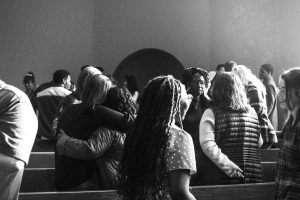Social distancing regulations cause confusion among students
Many consider social distancing regulations to be contradictory
October 1, 2020

This is a time of uncertainty and confusion, and that’s putting it mildly.
Restrictions on social gatherings due to the COVID-19 outbreak have now become a normal part of everyday life. Everyone is reminded of it every time they walk out of their room.
Seattle Pacific University has made the health and safety of its students, faculty and staff a priority by implementing social distancing guidelines on campus. Limited in-person classes, students are required to wear masks everywhere they go, sanitize their hands every chance they get, social distance and be with a limited number of people outside of the classroom are among the guidelines set in place.
The students of SPU have an opportunity many others do not—many schools around the country still are not able to welcome students on campus—but that does not mean students fully understand the regulations that SPU has put in place.
At the beginning of the school year, some may have considered the incoming freshman students to be reckless when they were socializing around campus with their classmates. Due to unclear communication, some of the students may have been confused about where and when the rules applied.
One of the rules around campus is that students cannot gather in a group with more than five people, and if they do, they could get in trouble and risk spreading COVID-19. This could result in certain halls having to quarantine, and the worst-case scenario having an outbreak on campus.
However, during orientation and in the classrooms there were more than five people in the room. Students considered this to be a contradiction. Why could more than five students be in the classroom, but limited to five on their own?
During an in-person interview, Ruth Addisu, a fashion major and freshman at SPU said, “SPU has been trying its best to distance us, but at the same time it is kind of strange since we have been going into classrooms of about 12” But students are responsible for avoiding groups of more than five if not there would be major consequences.
It is understandable why someone would consider this to be contradictory. A student can socialize with their friends in the classroom, but then when they’re outside, they risk getting in trouble for it. According to Addisu, when they are in a group of five, nothing happens, but when a person gets added into the group it results in a member of staff giving them a stern talking to. Students can consider the rules to be unfair, and need clarification for why the regulations are not consistent.
To correct the confusion, Chuck Strawn, the Dean of Students for Community Life, clarified that the regulations are not consistent because it depends on the circumstance and environment.

Strawn said, “My understanding of the Washington State and King County guidelines are that you are not supposed to have groups more than five unless it is under specific circumstances that are approved.”
Orientation and classrooms fall under those specific circumstances.
Guidelines for classes and social outings differ because it all depends on how well the environment can be sanitized. “In those spaces, it is primarily not about group size, it is about other factors that can be managed. Like how spread out can you be, what is the airflow, how can those places be sanitized,” Strawn said.
But besides the complicated layers of the guidelines, the miscommunication of those guidelines does not help students successfully follow them. It could account for students not following the regulations at the beginning of the year. The school could have been much clearer with what the rules were.
The school sent out multiple emails regarding regulations to students before coming onto campus and expected students to read and memorize them. There were emails being sent out practically every day for many months, it was hard to keep track. With the beginning of a new chapter in your life, reading a bunch of emails about health guidelines that had been piling up isn’t your priority.
Sierra Lebovitz, a social justice major and sophomore at SPU, said, “I don’t believe that it was entirely fair of administration to have expected the students, in the frenzy of moving in, making friends, and moving to a new place to remember exactly what the expectations were.”
The school expected students to read all of the emails and know all the rules by the time they got to campus. Confrontation over a required Zoom/ in-person meeting would’ve been more effective at the beginning. If the administration had made this the priority, students would have been more conscious about the regulations. “Saying the rules to you face to face, there’s no way you could miss it,” Lebovitz said.
The school doesn’t want to restrict students’ social lives, this is just the best way they know how to keep everyone safe. Students want a normal college life so badly, they can try to pretend that there aren’t any regulations and fight against them. But would you rather get sent home due to COVID-19 or follow a couple of guidelines to prevent that?
“If I got sick, that means around 20 people are stuck in their rooms for two weeks,” said Lebovitz. “You have to think about that.” She stresses the fact that students need to be mature about this, they need to act like adults.
“This is a virus that attacks us exactly where God has created us. We are created for connection, and this is spread socially,” said Strawn.
Strawn believes the regulations are enforced so we can protect ourselves and our fellow students, otherwise, things could take a turn for the worst.
To put it plainly: it sucks, but it is better than nothing.
The rules are here for your own good, the problem is that they haven’t been clear. It’s understandable why people want to fight against the rules; it is difficult to follow rules you don’t understand. But that is not a good enough excuse for ignorance. Don’t use your lack of information as an excuse to disregard the regulations that are made to protect you. The school has people that can answer questions.
Don’t walk around acting clueless and unconcerned. The more we abide by the regulations and take other people’s health into consideration now, the sooner life will go back to normal.


























































































